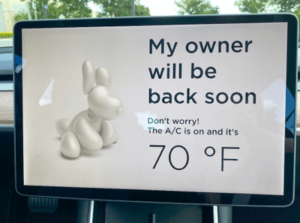Dogs Left In Hot Cars
Pups, kisses, and starfish wishes. The summer weather is here and for many pet owners this means plenty of sunny adventures with their furry friend. However, for many pet owners sunny days end in tragedy. This is because many pet owners are still leaving their dogs in hot cars despite knowing the dangers. By now many pet owners understand the implications of leaving a dog inside of a hot car. That’s because dogs left in hot cars are not able to keep themselves cool the same way that we can. Leaving a dog in a hot vehicle is very dangerous and can become life threatening in just a matter of minutes.
WARNING
Due to the serious nature of topics discussed in this article, Some of the details may be graphic and unpleasant to the reader.
Did you know?
An external temperature of 71°F (22°C) can turn to 113°F (45°C) in just minutes?
Vets Now | vehicle temperature chart.
There is no reason why you should ever leave your beloved dog in a hot car. Leaving a crack open in the window makes absolutely no difference. You wouldn’t leave your baby inside of a hot car, the same logic applies to your animal companions.
As an Animal Protection Officer, I had responded to numerous calls re: dogs left in hot cars. Fearing the worst, this would always cause me to experience a great deal of anxiety. In some cases, the dog would show minor to moderate signs of heat stroke such as panting heavily but would otherwise be ok if removed from the hot vehicle in time. The pet owner would get a piece of my mind along with a hefty fine for leaving their dog in a hot car.
Other times I would arrive on scene and the dog would be unresponsive, clinging to life and gasping for air. The dog would be far gone at this point and suffering from a fatal case of heatstroke. This was always a heart-breaking sight to see.
For those who don’t know, in extreme heat stroke cases the dog may act ok when removed from the vehicle and given water, however shortly after the dog will begin to seizure and expel parts of their liquified organs before succumbing to an awful death.
This indeed is one of the most tragic ways to lose a pet. More importantly this type of death and suffering is 100% preventable.
Why Are Dogs Left In Hot Cars?
Almost all the pet owners would claim that they just had to run into the store for a quick minute, but we all know how quickly a minute turns into half an hour. Either the checkout lines are too long, or maybe they simply got distracted and lost track of time.
Meanwhile the clouds have cleared, the sun came out and the humidity became heavy.
The perfect recipe for disaster in just moments. The temperature rises from 75°F (24°C) to a whopping 113°F (45°C) and the dog starts panting, becomes thirsty and is having trouble breathing. The heart rate rises, and the dog begins to panic.
By now the dog’s internal temperature has risen from 102°F to 109°F (38.8°C to 42.7°C). from exposure to the excessive external temperature. At these critical temperatures the dog is now experiencing multiple organ failure and impending death, all of which could have been easily prevented by being a responsible pet owner.
How You Can Help When You See A Dog Trapped Inside Of A Hot Car
Look at the vehicles parked in the lot. If there is a dog left inside of the hot car it should be obvious and a lot of the times they will bark. If it’s a hot day, and the windows are up, it’s reasonable to assume that the dog is in distress. The car may be running with the A/C on so listen to see if you can hear the engine running.
NOTE: leaving a running car unattended with a dog inside is also irresponsible and not best practice.
NOTE #2 : Tesla cars have a built-in doggy cooling function. (you are a brilliant man Elon Musk) This means that the vehicle is locked with the dog inside. A climate control setting is keeping the dog cool while the owner is out and about. This can be confirmed by looking at the large screen inside of the car.

If you encounter a dog inside of a hot vehicle and have a reasonable assumption that the dog is in distress, immediately call 911. If you are with somebody, instruct the other person to go inside of the store and have customer service page the owner of the vehicle. Make sure to write down the license plate number, make and model of the vehicle.
Do Not Break The Window 😉
A dog trapped in a hot car might tug at your heartstrings and make you want to break the window. Seeing a dog trapped inside of a hot car might tempt you to react and smash the window to save the dog. Keep in mind that although you want to do the right thing, technically the car and the dog are someone’s personal property.
This means that you can be legally responsible for the damages. When you call 911 dispatch will provide you with instructions based on the situation and severity of the dog’s condition.
Only Police Officers have the legal authority to break a car window for the purpose of saving a trapped dog. Breaking the window is dangerous and may result in serious injury to you and the dog.
Signs Of Heat Stroke In Dogs
Signs of a heatstroke in dogs can be quite easy to spot if you know what to look for:
- Excessive panting
- Drooling
- Uncoordinated movement
- Vomiting
- Collapsing
- Diarrhea
- Mental dullness
- Loss of consciousness
- Red gums
Heat stroke in dogs can be extremely dangerous and can cause numerous unseen health problems such as:
- Kidney failure
- Heart failure
- Blood Clots
- Swelling of the brain
- Intestinal bleeding
NOTE: Older dogs and long hair dogs are at a higher risk of developing heat stroke.
What To Do When A Dog Is Showing Signs Of Heat Stroke
Dogs that show signs of heat stroke require immediate Veterinary care to rule out any of these unseen medical conditions. When transporting a dog to the Vet, Keep the A/C on in the car. If your car doesn’t have A/C, keep all the windows open.
How A Veterinarian Will Treat A Dog With Heat Stroke
The Vet will examine the dog for secondary complications, such as kidney failure, neurologic symptoms, abnormal clotting, changes in blood pressure, and abnormalities in electrolytes. The Vet will also check the dog for dehydration and may provide intravenous fluid therapy to replace fluids and minerals.
Fun Fact:
Dogs cannot sweat through their skin, so to regulate their body temperature and stay cool they pant and release heat through their paw pads and noses.
You may also enjoy our Article on Effective Ways To Keep Your Dog Safe From Coyotes










